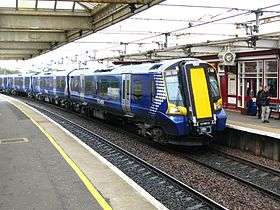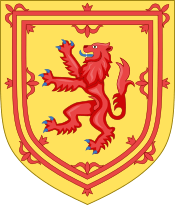Transport in Scotland
The transport system in Scotland is generally well-developed. The Scottish Parliament has control over most elements of transport policy within Scotland and the Scottish Government's Enterprise, Transport and Lifelong Learning Department is responsible for the Scottish transport network with Transport Scotland being the Executive Agency that is accountable to the Cabinet Secretary for Finance and Sustainable Growth.[1]
Railways
Scotland has an extensive railway network, with links across the country, connections to England, local commuter links to the major cities (many of which were electrified under British Rail) and freight. As of 2018, the total route length of the rail network in Scotland is 2,819 km (1,752 mi). 709 km (441 mi) of the rail network is electrified, and there are 359 stations.[2]
The railway network is owned by Network Rail, which is responsible for the majority of the railway infrastructure. Rail services are provided under franchises awarded by the government. The current holder of the Scottish franchise is Abellio ScotRail. Intercity services are also operated by Avanti West Coast, CrossCountry, London North Eastern Railway and TransPennine Express.[3]
On 1 January 2006, Transport Scotland was established, which would oversee the regulation of railways in Scotland and administer major rail projects.[4]
Cross border services
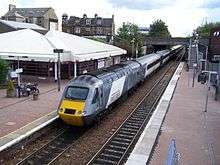
The main cross border services in Scotland are:
- The West Coast Main Line – operated by Avanti West Coast and TransPennine Express
- Services from Edinburgh Waverley, Glasgow Central) and Motherwell to Manchester Airport, Birmingham New Street and London Euston
- East Coast Main Line – operated by London North Eastern Railway
- Services from Inverness, Aberdeen, Glasgow Central and Edinburgh Waverley to London Kings Cross[5]
- Cross Country Route – operated by CrossCountry
- Services from Aberdeen, Dundee, Glasgow Central and Edinburgh Waverley to Leeds, Sheffield, Derby, Birmingham New Street, Bristol Temple Meads, Exeter St Davids, Plymouth and Penzance
- Caledonian Sleeper – overnight sleeper services
- Services from Inverness, Aberdeen, Fort William, Glasgow Central and Edinburgh Waverley to London Euston
- Glasgow South Western Line – operated by Abellio ScotRail
- Services linking Carlisle, Dumfries, Kilmarnock, Glasgow Central, Paisley, Troon (for P&O Ferries to Larne), Ayr and Stranraer (with links by bus from the two latter stations to Cairnryan, for P&O Ferries to Larne or Stena Line to Belfast).
Scottish services

Within Scotland, 94% of passenger service trains are operated by ScotRail, with the remaining 6% being cross border.[6] Until 2005, services within the former Strathclyde Regional Council area were provided by First ScotRail on behalf of SPT.[7]
History
The first railway in Scotland was the Monkland and Kirkintilloch Railway, opened in 1826. The first passenger railway was the Kilmarnock and Troon Railway.[8] The first railways in Scotland were operated using horse traction. By 1850 Scotland's major cities were linked to each other and to the rest of the British rail network. The second half of the 19th century saw a rapid expansion of the network, and by 1900 virtually every town with a population greater than 2,000 on the Scottish mainland had a railway station. At the same time trains became more comfortable, faster and more frequent whilst the cost of travel declined relative to wages.
Nevertheless, there were probably never more than 100 million or so journeys made per year within Scotland, little more than 20 per head of population, illustrating how most people had little need, financial means or desire to travel long distances. Railways did, though, play an important part in moving freight, especially heavy loads such as coal, iron and steel, and played a vital role in the First World War.
After World War I, the Railways Act 1921 also known as the Grouping Act, merged the Caledonian Railway and its rival, the North British Railway into the newly created London, Midland and Scottish Railway and London and North Eastern Railway companies.
After World War II, the railways were nationalised by the Transport Act 1947 into British Railways. The Scottish network was reorganised as the Scottish Region (ScR), one of six new regions of British Railways.
By the late 1950s the railways were running at a loss. In 1963, the government appointed Dr. Richard Beeching as chairman of the British Transport Commission. He commissioned a report called The Reshaping of British Railways also known as the Beeching Report that intended to reorganise the railways to become more profitable. This led to the infamous Beeching cuts, resulting in 650 miles of track and associated stations being closed.[9] The closures were deeply unpopular by many people affected and resulted in protests, most notably the Waverley Route.[10]
The closure programme slowed down after the Transport Act 1968 made it possible for the government to directly subsidise loss-making lines and the last major closures in the 1970s, were the direct Edinburgh–Perth Glenfarg line and the Formartine and Buchan Railway which connected Peterhead and Fraserburgh to Aberdeen.
In the 1980s British Railways (by now renamed as British Rail) rebranded the Scottish Region as ScotRail.
British Rail was privatised in March 1997. The Scotland franchise was won by National Express who decided to retain the ScotRail brand and operated the franchise until 2004. The Scotland franchise was then operated by First ScotRail until 2015 when Abellio ScotRail was awarded the franchise by the Scottish Government. The Caledonian Sleeper service, which had previously been operated by the Scotland franchise holder from 1997, was separated as a new franchise in 2015. It is currently operated by Serco.[11]
Since 1997, rail usage has risen, which has resulted in the reopening of former railway lines and stations closed under the Beeching Axe. Major reopenings include:
- Airdrie–Bathgate rail link – reopened a fourth link between Edinburgh and Glasgow.
- Stirling–Alloa–Kincardine rail link - reconnected Clackmannanshire to the rail network.
- Borders Railway – partial reopening of the Waverley Route
Glasgow Subway
The Glasgow Subway is the only underground system in Scotland. It opened on 14 December 1896, making it the third oldest underground network in the world. It is owned and operated by Strathclyde Partnership for Transport.
Trams and light rail
Edinburgh Trams opened on 31 May 2014. It is the only system currently in operation in Scotland, although Aberdeen, Dundee, Edinburgh and Glasgow formerly had extensive networks.
Road
Scotland has an extensive road network throughout the country. The motorway network is concentrated in the Central belt, with trunk roads (A roads) connecting the rest of the country.
Major routes in Scotland include:
- The M74 motorway and A74(M) motorway between Glasgow and the M6 at Carlisle
- The M77 motorway/A77 road between Glasgow, Kilmarnock, Ayr and Stranraer
- The M9 motorway between Edinburgh and Bridge of Allan
- The M8 motorway between Edinburgh, Glasgow and Greenock
- The M80 motorway between Glasgow and Stirling
- The M90 motorway between Edinburgh, Kinross and Perth
- The A1 road between Edinburgh, Musselburgh, Haddington, Dunbar, Berwick and London
- The A82 road between Glasgow, Crianlarich, Fort William and Inverness via Loch Lomond and The Trossachs and Loch Ness
- The A9 road between Falkirk, Stirling, Perth, Pitlochry, Aviemore, Inverness, Golspie, Thurso and Scrabster ferry terminal, (connecting to the Northlink Ferries ferry to Stromness, Orkney) via The Cairngorms
- The A90 road between Edinburgh, Perth, Dundee, Forfar, Stonehaven, Aberdeen, Peterhead and Fraserburgh
Traffic
Within the large cities, roads become congested in peak hours. The M8 and M77 motorways become heavily congested in peak hours, especially around Glasgow where it travels through the heart of the city. The main congestion hotspots are in Glasgow City Centre around the Kingston Bridge where a large amount of traffic leaves and enter the road. Also further down the road traffic joining at Hillington Estate and Braehead Shopping Centre near Glasgow Airport can cause hold-ups. Traffic is also extremely heavy between Glasgow and Edinburgh at all times, however rarely comes to a standstill.
Road construction
An extension to the M9 spur to link with the A90 at the Forth Bridge recently opened, as did the new Clackmannanshire Bridge over the Firth of Forth. A controversial extension to the M74 motorway through the southside of Glasgow was also completed in 2011. The road, first proposed in the 1960s, was due to be open in 2008 however legal action against the road was brought by environmental group Friends of the Earth. The action ultimately failed; however, the motorway has widespread opposition after ministers over-ruled the Local Public Inquiry held into the project which recommended that the road not be built, as it would be unable to substantially reduce congestion and would lead to more vehicles and pollution in the area. The Scottish Ministers voted for the road, believing that it will regenerate the inner city of Glasgow's Southside and bring economic benefits to Renfrewshire, Inverclyde and the Southside of Glasgow. Construction cost is estimated at £575 million, and it is Scotland's biggest roads project, and the first motorway to be built in a British urban area for decades.
| Motorways of Scotland | ||
| M73 – M74 – M77 – M8 – M80 – M876 – M898 – M9 – M90 | ||
| A-roads with motorway restrictions | ||
|---|---|---|
| A74(M) – A823(M) | ||
Buses
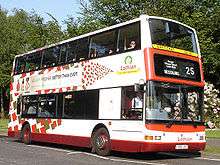
Scotland is covered by a large bus network throughout many towns, cities and rural areas. It is estimated that 95% of the population live within 5 minutes walk of a bus stop. National and international buses often operate out of main bus stations in the cities, such as Buchanan bus station in Glasgow and Edinburgh bus station.
Scottish Citylink and Megabus are the two principal long distance coach operators within Scotland, and currently operating together as a joint venture, however the deal is being monitored by the competition commission to ensure that it does not unfairly damage long distance bus travel in Scotland. National Express provide coach links with cities in England and Wales, as well as local buses in Dundee and Angus under the Xplore Dundee and Travel Wishart brand names.
FirstGroup and Stagecoach Group are two large public transport companies which are based in Scotland at Aberdeen and Perth respectively, and both operate a number of local and regional services.
National Express is the only other public transport giants that serves Scotland with its Xplore Dundee subsidiary, serving the city of Dundee.
Numerous local independent operators also run bus services throughout Scotland as well as Lothian Buses, Edinburgh's largest bus operator and Scotland's last council run bus company.
Scotland's bus network, like that of Great Britain outside London, is deregulated following an act of UK Parliament in 1986. This broke up the former national and city bus companies, formerly run by the local authorities since the 1930s, into private companies. The act also allowed buses to be operated by private companies and individuals for profit, provided they met the financial, background and maintenance requirements to qualify for a licence, set down by Vehicle & Operator Services Agency who administrate the system. A Public Service Vehicle Licence is then granted to allow a specified number of vehicles to be operated. Using this licence firms can then register their routes with the Local Traffic Commissioner for the area, in this case Scotland, indicating the exact route to be operated as well as the times and dates their buses will run. No requirements are set as to when and what routes buses can run, their age and what fares can be charged-this is decided by companies, often by the profitability of the route. Currently only one bus company, Lothian Buses in Edinburgh, remains under ownership and control of local councils in Lothian and Edinburgh.
Water
Ferries
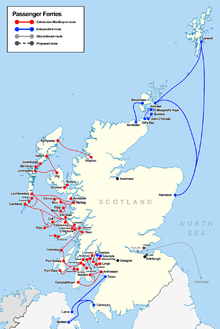

As Scotland is made up of several hundred islands, water has always been an important transport route for passengers and freight, particularly in the remote communities of the Hebrides.
There are several ferry companies operating in Scotland including:
- Caledonian MacBrayne, a publicly owned ferry company with routes linking the mainland to all the major islands of the West Coast
- Northlink Ferries is a state backed company that serves the Orkney Islands and Shetland Islands, linking them with Aberdeen and Scrabster
- Pentland Ferries, car and passenger ferries from Gills Bay (Scottish Mainland) to St. Margaret's Hope (Orkney).
- Stena Line link Stranraer to the Belfast in Northern Ireland
- P&O provide links to Larne in Northern Ireland from Stranraer and Troon
- DFDS operate the Rosyth - Zeebrugge ferry service (freight only since 2010), formerly operated by Superfast Ferries and Norfolkline
- Western Ferries (Clyde) Ltd, a private company, based in Hunters Quay, Argyll, operates on the Firth of Clyde, providing a frequent vehicle link between Hunters Quay, Cowal and McInroy's Point, Gourock, Inverclyde.
- Argyll Ferries, a subsidiary of David MacBrayne Ltd, formed in 2011 to provide the service between Gourock and Dunoon town centres. The public funded service route.
- SIC Ferries, owned by the Shetland Islands Council provide inter-island services in Shetland
- Orkney Islands Council own Orkney Ferries, who provide inter-island services in Orkney
The Strathclyde Partnership for Transport, formerly Strathclyde Passenger Transport, the only regional passenger executive in Scotland also subsidises and operates ferries on the Clyde including the Kilcreggan Ferry and the Renfrew Ferry.
The ferry to Gothenburg, Sweden, from "Newcastle" (actually North Shields) in northern England (currently run by the Danish company DFDS Seaways), ceased at the end of October 2006.[12] This service was a key route for Scottish tourist traffic from Sweden and Norway. The company cited high fuel prices and new competition from low-cost air services, especially Ryanair (which now flies to Glasgow Prestwick and London Stansted from Gothenburg City Airport), as being the cause. DFDS Seaways' sister company, DFDS Tor Line, will continue to run scheduled freight ships between Gothenburg and several English ports, including Newcastle, and these have limited capacity for passengers, but not private vehicles. The Newcastle-Kristiansand, Norway, route has however recently been cancelled.
Waterways
Scotland never had an extensive canal network. The Forth and Clyde Canal, Union Canal and the Caledonian Canal were some of the most important, but went into decline after the growth of the railways. They are now being reopened and restored primarily for leisure use.
Air transport
Scotland has five international airports with scheduled services, operating to Europe, North America and Asia, as well domestic services to England, Northern Ireland and Wales.
Highlands and Islands Airports Limited operates eleven airports across the Highlands, Orkney, Shetland and the Western Isles, which are primarily used for short distance, public service operations, although Inverness Airport has a number of scheduled flights to destinations across the UK and mainland Europe.
British Airways, EasyJet, Flybe, Jet2 and Ryanair operate the majority of flights between Scotland and other major UK and European airports.
There are currently four Scottish-based airlines:
See also
- Transport in the United Kingdom
- Transport in England
- Transport in Wales
- Transport in Northern Ireland
- Transport in the Republic of Ireland
- Transport Scotland
- NaPTAN
- Rail transport in Great Britain
- Scotch gauge
- List of Tramways in Scotland
References
- "Scottish Cabinet". Scottish Executive. Retrieved 26 May 2007.
- "Chapter 7: Rail Services". www.transport.gov.scot. Transport Scotland. Archived from the original on 16 March 2019. Retrieved 12 March 2019.
- "National Rail: Companies and coverage guide". NationalRail.co.uk. Retrieved 4 May 2019.
- "Corporate: Freedom of Information Publication Scheme". Transport in Scotland. Retrieved 24 September 2014.
- "National Express awarded contract for growth on InterCity East Coast". Department for Transport. Archived from the original on 19 December 2007.
- https://www.transport.gov.scot/media/41863/scottish-transport-statistics-2017-with-correction-to-table-214.pdf
- "All Scotland's trains to get Saltire livery".
- "Plaque marks pioneering railway". BBC News. 6 July 2012.
- "450 miles of Scots railway 'dodged Beeching axe'".
- Brocklehurst, Steven (27 March 2013). "What was Beeching's worst railway cut?". Retrieved 4 May 2019 – via www.bbc.co.uk.
- "Overnight Sleeper Trains - Caledonian Sleeper Experience". Caledonian Sleeper. Retrieved 4 May 2019.
- "DFDS scraps Newcastle-Gothenburg line" Archived 28 August 2007 at the Wayback Machine, The Local, 7 September 2006: "Danish shipping company DFDS Seaways is to scrap the only passenger ferry route between Sweden and Britain, with the axing of the Gothenburg-Newcastle route at the end of October."
Further reading
- Cowsill, Miles; Hendy, John (1992). Ferries of Scotland. Kilgetty, Pembrokeshire: Ferry Publications. ISBN 978-0951309346.
- Hendy, John (2010). Ferries of Scotland. Vol. 2 (new ed.). Narberth, Pembrokeshire: Ferry Publications. ISBN 9781906608194.
External links
- Transport Scotland Key facts
- Scotland Railways Scottish Rail site with timetables, maps and cross-network passes for foreign travellers in Scotland.
- Coach and Bus Routes leaving from Scotland
- Coach and Bus Routes going to Scotland
